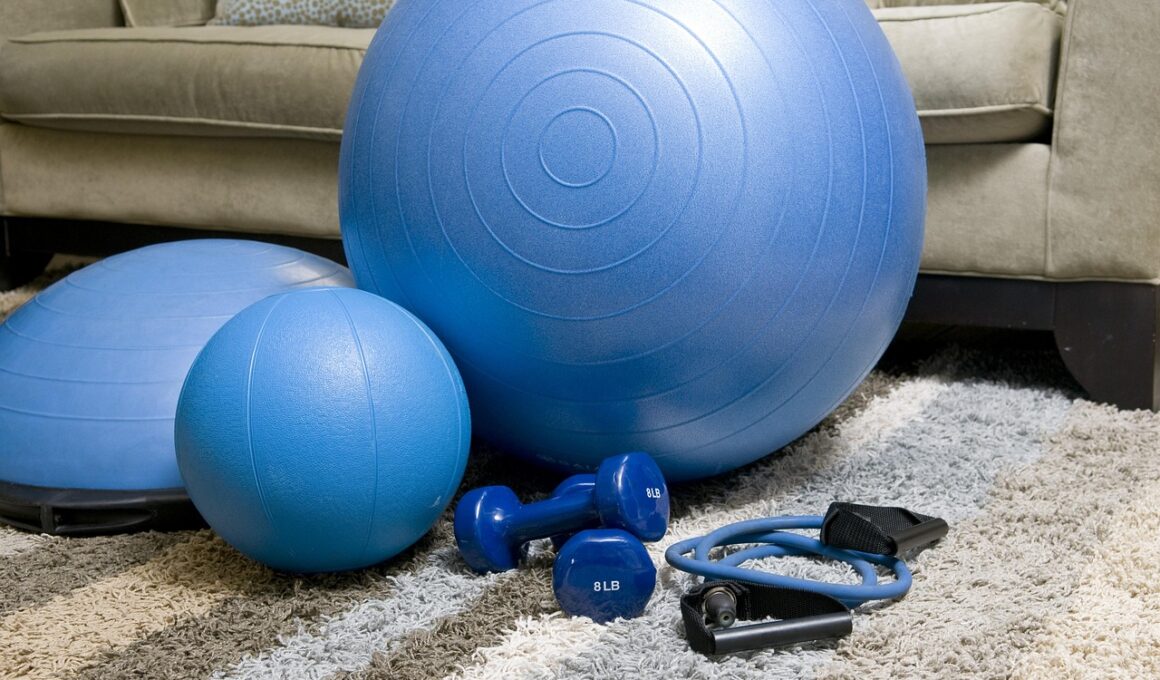Creating a Home Gym for Week 5 Core Stability Training
Establishing a successful home gym is vital for anyone aiming to enhance their fitness routines. Having the right environment can significantly improve motivation and workout effectiveness. As we delve into core stability training for Week 5, it’s essential to equip your gym with the necessary tools. Begin by selecting an appropriate space in your home. A garage, spare room, or even a corner of your living room can be transformed into an effective workout area. Ensure this area is free of distractions and has sufficient space for movement. The next step involves procuring the proper equipment. Consider a quality yoga mat for comfort during floor exercises. Stability balls, resistance bands, and balance boards should also be on your list. These tools provide varied options to target different muscle groups while enhancing stability throughout your core workouts. To maximize the space, keep all items organized and easily accessible. Additionally, incorporating mirrors can help you maintain proper form. Choose the right lighting to create an inviting atmosphere that encourages your dedication. This planning sets the stage for effective core stability training in Week 5.
Core stability is not just about physical strength but also mental engagement. As you move through your core stability workouts, remember to focus on both the technique and breathing aspects. Integrating proper breathing techniques helps in activating your core muscles effectively. For instance, exhaling during challenging movements ensures that you engage your core deeply. Moreover, consider tracking your progress. Maintain a workout journal to note improvements, challenges, and feelings towards your workouts. This practice allows you to celebrate small victories and keep you accountable. Recording your workouts could help you adjust training intensity and focus areas for better results. Bringing in elements of fun can also enhance your weekly training sessions, such as incorporating your favorite music or inviting a friend to join. A partner can bring an element of competition and collaboration to your workouts. Mixing in various training modalities is beneficial too; think about combining traditional exercises with yoga elements for enhanced flexibility and control. This varied approach can help prevent burnout and maintain excitement, ensuring you remain productive during your Week 5 core stability training sessions.
Essential Equipment for Home Gym
To create an effective home gym focused on core stability, selecting the right equipment is crucial. Start with versatile items like resistance bands, which are affordable and space-saving. These bands offer varying levels of resistance to challenge your core muscles and improve stability. Another essential piece is a stability ball, which engages multiple muscle groups while promoting balance and flexibility. This tool is also perfect for performing exercises such as ball passes or wall squats. Learn to utilize bodyweight exercises effectively, as they require no equipment and can target your core effectively. Incorporate moves like planks, mountain climbers, and Russian twists into your routine. These exercises allow for functional strength training that is desirable for everyday activities. A foam roller can also be beneficial for post-workout recovery, aiding muscle relief and flexibility. Additionally, a set of dumbbells can add intensity to your workout by allowing for weighted exercises targeting core stability, such as weighted sit-ups or side bends. Don’t overlook space; adequate room to move freely is just as important as the equipment itself.
Creating a dedicated workout space does not need to break the bank. Consider utilizing what you already have before making any purchases. You might find objects around your home that can be adapted for your training. Household items like water bottles or sturdy chairs can substitute for gym equipment. Additionally, use online resources to access workout videos or virtual classes. Numerous platforms offer free or subscription-based classes tailored to core stability training. Set a weekly schedule that aligns with your lifestyle to ensure consistency and maintain focus. Designate specific days and times for your workouts, treating them as unmissable appointments. Furthermore, customizing your workout environment can bolster motivation. Keep your space clutter-free and add personal touches that inspire you. This might include motivational quotes, images of fitness goals, or calming colors. Finally, engage with online fitness communities for support and accountability. Participating in social media fitness groups can provide inspiration, ideas, and connection with fellow fitness enthusiasts. This interaction enriches your journey and ensures you stay on track during your core stability training progression.
Creating a Routine
The foundation of effective training is a structured routine that promotes core stability. Begin each workout with a dynamic warm-up that prepares your body for the more strenuous exercises to follow. This could include light cardio such as jumping jacks or slow jogging, paired with mobility drills. After warming up, target your core through a planned sequence of exercises focusing on stability. Incorporate hold times that challenge your control while ensuring proper alignment. Exercises like planks and side planks lay the groundwork for building core strength. Also, ensure you’re including variations and progressions as you adapt to the workouts. For ultimate improvement, gradually increase the duration or intensity of your holds. Post-workout stretching is crucial for recovery; it promotes flexibility and prevents strain. Dedicate time to stretches focusing on the core and lower back to help release tension. Consider experimenting with different workouts or combinations each week to keep your routine refreshing. Rotating exercises can continue to challenge your muscles, fostering growth and stability. Tracking your progress over the weeks also allows reflection on your improvements and adjustments as necessary.
As you dive into Week 5 core stability training, remember to listen to your body. Prioritize form over quantity during each exercise to prevent injuries. Start with fewer repetitions focusing on quality and proper engagement. As the workouts progress, you can gradually add intensity, allowing your muscles time to adapt. Include sufficient rest and recovery days to maintain a sustainable practice. Taking breaks allows your muscles to repair and grow stronger, vital for achieving long-term fitness goals. Ensure your post-workout nutrition aligns with your training regimen. Fuel your body properly with balanced meals containing proteins, carbohydrates, and healthy fats; this combination supports muscle recovery and energy replenishment. Don’t hesitate to personalize your workout plan according to your specific needs. If a particular exercise feels challenging, modify it to suit your current abilities. Utilizing apps or workout planners can facilitate program customization tailored to your focus areas that need improvement. Additionally, embrace the role of mindset in your fitness journey. Cultivating a positive attitude creates resilience against challenges you may face during workouts. Celebrate every achievement, big or small, on the path to mastering core stability.
Engagement Through Community Support
Engaging with a community can greatly enhance your workout experience and motivation. Whether online or in-person, sharing your fitness journey creates accountability and encouragement. Seek out local workout groups or forums that focus on core stability and fitness. These communities provide valuable resources, tips, and support from individuals with similar goals. Connecting with others helps stave off feelings of isolation during your fitness journey. Virtual challenges, event participation, and group workouts can amplify motivation and create a fun environment for progress. Also, take the time to share your successes on social media; celebrating achievements can inspire others and create supportive dialogue. Collaborate with workout buddies either virtually or physically to amplify results and create a more enjoyable experience. A buddy system can add an element of accountability, as checking in on each other’s progress offers additional support. Additionally, consider working with a personal trainer, even on a short-term basis, to receive expert guidance tailored to your needs. This external advice helps make safer and more effective workout choices that align with your core stability goals. Focus on building a supportive network as part of your holistic fitness journey.
As you progress, incorporating mindfulness into your workouts can enhance overall well-being. Focus on connecting your breath with movement during core stability exercises. This technique improves concentration and makes workouts feel less routine. Mindfulness helps foster better body awareness, crucial for maintaining form throughout your training. Implementing practices like yoga or Pilates on rest days can also complement your core training. These disciplines emphasize controlled movements and breathing, enhancing your core strength. Through intentional movement, you not only build stability but also cultivate mental resilience. Furthermore, reflection at the end of each week is essential for tracking progress. Consider journaling insights about what workouts felt beneficial and where adjustments are necessary. This habit allows for greater understanding of your body’s responses and preferences. Celebrate milestones, no matter how small, to maintain motivation. Additionally, don’t forget to allow flexibility in your workout plan; adapting it as needed keeps the experience engaging. Combining all these elements creates a comprehensive home gym and workout plan tailored to your core stability goals. Remember, the journey is just as important as the destination, encouraging persistence and growth.


